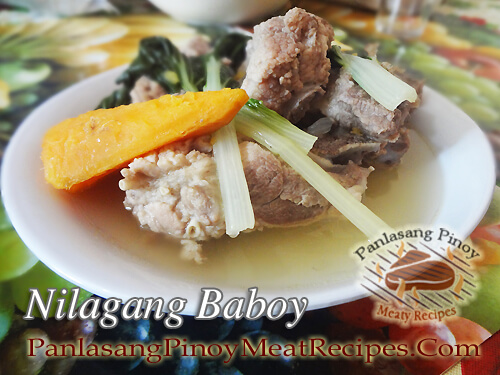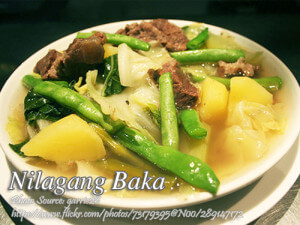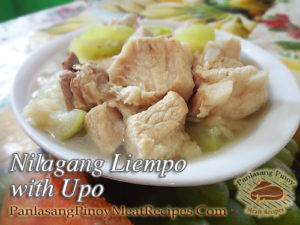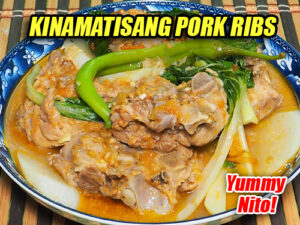Nilagang baboy or boiled pork ribs or pork belly with vegetables is a very simple Filipino soup dish. The good thing about this dish is that you can substitute the vegetables cooked with the pork. For example, instead of potatoes, you can use sweet potatoes. In the absence of pechay, you can use bok choy. This dish very versatile and simple.
And with regards to pork, choose pork ribs with thin layer of fat and remove the skin as much as possible. Because sometimes the skin has an unpleasant smelly swine odor specially male pigs. And you can actually taste that on the dish. We always remove the skin whenever we cook pork (except when frying like lechon kawali or crispy pata) but we keep it in fridge until there are plenty and enough to make pork rind cracklings or pork chicharon.
Boiled Pork Ribs Soup: A Taste of Home in Every Bowl
When it comes to comfort food, nothing takes me back to childhood quite like a steaming bowl of this savory boiled pork dish. Growing up in a household where food was at the heart of every gathering, this humble soup was a frequent star on our dining table, especially on lazy Sunday afternoons. My mother would often make a large pot of this hearty dish, and the aroma of pork simmering slowly on the stove would drift through the house, signaling it was time to gather around.
This classic Filipino dish is loved for its simplicity and versatility. What I appreciate the most is how it can be tailored to whatever ingredients you have on hand. While we often used pork ribs, my aunt, for instance, prefers using pork belly for that extra layer of richness. Vegetables can vary too, depending on what’s available or in season. I’ve seen this dish made with everything from potatoes to sweet potatoes, and if pechay isn’t available, bok choy works beautifully as a substitute. It’s this flexibility that makes this comforting soup a favorite in many Filipino homes.
A Simple Dish with So Much Flavor
At its core, this boiled pork dish might seem simple. After all, it’s just pork simmered in water, seasoned with salt, and accompanied by a few vegetables, right? But don’t let its simplicity fool you. Each component contributes to a flavorful and heartwarming broth that’s both light and deeply satisfying. The key to achieving that perfect balance lies in choosing the right cut of pork. In my family, we always go for pork ribs with a bit of fat. This adds a richness to the broth without overwhelming the flavors of the vegetables.
A quick tip I learned from my uncle: always remove the pork skin before boiling. While it might seem like an extra step, it makes a significant difference. Pork skin, especially from male pigs, can sometimes give off a strong, gamey odor that can affect the entire dish. So, we carefully trim it away, saving it in the freezer for another day when it can be transformed into crispy chicharon. This small step makes sure the broth stays clean, pure, and full of flavor.
Cooking Secrets Passed Down Through Generations
Every family has their little secrets when it comes to cooking, and mine is no different. My grandmother would always say, “The secret to a good boiled pork dish is patience.” And she wasn’t wrong. Cooking this dish isn’t about rushing—it’s about letting the flavors develop slowly. You start by boiling the pork until scum rises to the surface, then carefully skimming it off to keep the broth clear. Only then do you add the onions and black pepper, allowing the flavors to meld together for at least an hour. This slow simmering process is what gives the broth its depth and richness.
When it comes to seasoning, a splash of fish sauce (patis) is non-negotiable in our house. My father insists that it’s what gives the dish its signature umami kick. Along with salt, patis elevates the soup, making each spoonful burst with flavor. Of course, you can adjust the seasoning to suit your taste, but I’ve found that a little patis goes a long way.
A Dish for Every Occasion
What makes this dish truly special is how it adapts to different occasions. On regular weekdays, we keep it simple—just pork, potatoes, and leafy greens like cabbage or pechay. But for larger family gatherings or special occasions, we like to make it heartier by adding more vegetables. Sweet potatoes add a touch of sweetness to the broth, while green beans or even corn can be thrown in for more texture. I remember when my sister came home from a trip to the province, she made her own version of this dish, adding saba bananas into the mix. The natural sweetness of the bananas paired with the savory pork was an unexpected twist that quickly became a new family favorite.
A Glimpse Into History
While this pork and vegetable soup might be a staple in modern Filipino households, its roots go back to the pre-colonial era. The method of slow-boiling meat and vegetables to create a flavorful broth has been a long-standing practice in Filipino kitchens. Over time, as trade with neighboring countries introduced new ingredients and techniques, the dish evolved. Yet, it never lost its simplicity or its status as a comfort food for Filipinos.
Historically, dishes like this were prepared using native ingredients and were a way to stretch food supplies, especially in rural areas. The addition of various vegetables wasn’t just for flavor, but also a practical way to make the dish more filling and nutritious. Even today, each household has its own twist on this timeless dish, adapting it to fit local ingredients and family preferences.
Bringing the Family Together
Whenever I make this boiled pork soup, it reminds me of home and the warmth of family gatherings. It’s a dish that doesn’t demand much, but in return, it gives you so much more. The simple act of preparing it feels like a connection to my roots, to the meals shared with loved ones over stories and laughter. Whether you’re new to cooking or a seasoned home chef, this dish is an invitation to slow down, savor each bite, and maybe even start a new tradition in your own kitchen.
So, the next time you’re in need of something comforting and easy to prepare, give this dish a try. It’s more than just a bowl of soup—it’s a taste of home, a nod to our history, and a reminder that sometimes, the simplest dishes bring the most joy.
How To Cook Nilagang Baboy (Boiled Pork Ribs)
Ingredients
- 1 kilo pork ribs or pork belly
- 1 bundle pechay
- 2 pcs sweet potatoes peeled and quartered
- 1/2 head cabbage quartered
- 1 medium size onion quartered
- 1 Tbsp. fish sauce or patis
- 1 Tbsp black peppercorns cracked
- 1/2 tsp. salt
- 2 liters water
Instructions
How to Cook Nilagang Baboy
- Remove the skin of the pork ribs or pork belly. Then slice it into 3/4 inch thick and 1 and 1/2 to 2 inch length.
- Fill a medium size pot with water and let boil. Then put the pork and boil until the scum floats.
- Remove the scum that rises above the broth and add more water if needed.
- Add in the onion and black pepper then cook for an hour or until the meat is tender.
- Add in the sweet potatoes, salt and patis and cook for another 5 minutes.
- Then add cabbage and pechay and simmer for half a minute. Adjust the taste if necessary by adding more salt.
- Remove from heat and serve hot.
Notes
Cooking Tips:
Choose the Right Cut of Pork
For the best flavor and texture, opt for pork ribs or pork belly with a thin layer of fat. The fat adds richness to the broth, but too much can make the soup greasy. Trim excess skin to avoid any unpleasant odor that may affect the dish.Skim the Scum for a Clear Broth
As the pork boils, scum will float to the surface—be sure to skim it off regularly. This step ensures the broth remains clear and appetizing. A cloudy broth can dilute the clean, fresh taste that makes this dish so comforting.Adjust the Vegetables Based on Availability
Feel free to substitute vegetables based on what’s available or in season. If you don’t have potatoes, try sweet potatoes for a subtle sweetness, or swap pechay with bok choy. These adjustments can enhance the dish while keeping its traditional essence intact.






This is also how my mom cooks her nilaga, with kamote. Kamote adds that sweet taste to the nilaga and if you crush a tiny piece, it thickens the broth just a little. I like your tip about removing the pork skin to rid the soup of that pork’s unpleasant smell. really helps especially if the pork is not as fresh as I’d like. Thanks for sharing your techniques that add that something special to the dish that we cant find in other recipes. Kudos and more power to your site!
Hi Rexj, Thanks for sharing your thoughts! I hope I can make a video of this recipe as soon as possible! Thanks again!
I’m glad you like this recipe. Cheers!
I really love to cook the recipe